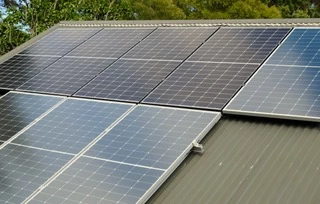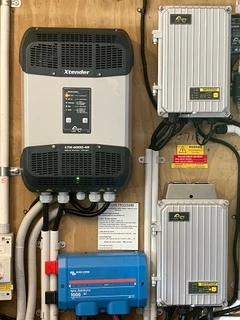My System

This is an installation I've designed myself, based around our existing 250Ah battery bank of Pb-C lead-acid batteries; eight 6v batteries in series for a 48v system. There are 14 solar panels in two separate arrays giving a total max power rating of 5.2Kw, making a good working balance with the 250Ah battery bank. The Studer inverter/charger is one typically used in an off-grid situation with an auto-switched backup generator feeding into the AC-in connections. In our situation we are connected to the grid and its inverter input is switched on and off with a switch on the main c/breaker board. This changes the operation mode between inverter mode (no grid input) and mains/charger mode (grid connected). In normal operation, certainly consistantly during the summer and/or mainly sunny days, the Studer is running in inverter made, with no grid connection, and its DC/AC inverter providing the energy to its loads. The batteries are being charged each day solely by the sunlight. So for much of the year the system runs essentially as an off-grid one. The mode is manually changed to mains/charger for periods where the solar provision is insufficient or for occasionally fully charging the batteries from the grid.

We have two c/breaker boards and they are both partitioned into two separated sections; one section fed by the inverter AC output and the other from the grid. The inverter part are the loads that we deem necessary to have power available at all times, often refered to as the 'critical loads'. These are the fridge/freezer, lights, some household power points (wifi modem, tv etc), heat-pumps, hotwater heat-pump and water tank pumps. By using a crossover switch in one of the c/breaker boards we can power these loads from the grid when neccessary. The rest of the loads, woodworking machinery, oven, clothes drier, dishwasher, washing machine, kitchen appliances and a few others are only ever fed by the grid. Given that we're committed to utility line charges anyway it seems logical to run these appliances without loading up the solar system, which means we have kept the system smaller and less expensive.
This configuration is a hybrid system in that it combines inputs from the grid, solar, DC-AC inverter and batteries but operates differently from the way a hybrid inverter does. This is a hands-on operation that requires manual adjustments from time to time whereas a hybid inverter does all the adjustments automatically. In either case you're always going to need a certain contribution from the grid, but with this system it's one or the other at any particular time and the two sources are not combined, as they are with a hybrid inverter. During the winter and/or darker days there is a need to monitor energy flows and occasionally manually switch between modes or put the inverter's share of the load onto the grid for periods when the batteries are not being charged. For long periods over summer months the system can run by itself without adjustements.
There's an upside to being invloved in its operation. There's no more wondering if the battery bank will be properly maintained, which was a constant worry with our previous hybrid experiences. There is a Studer remote control centre inside the house from which we can monitor everything and reset any operational parameters should something need changing. The Studer's operating mode is controlled from a circuit breaker inside the house and its 50a mains charger can be switched on manually when needed and its progress monitored on the remote control. This won't suit everyone.
The beauty of this Studer system is its versatility, simplicity and robustness. The XTM4000 inverter basically consists of a DC-AC inverter, a powerful AC battery charger and a transfer relay and the operational control electronics. It has no internal MPPT solar energy input ports; the solar charging is done with two externally mounted solar charge/controllers. All of these three units are low frequency pieces with a transformer employed rather than high-frequency transistor switching of most other systems. It is designed for off-grid operation where it's running 24/7/365.
The battery bank is attached to a Studer BMS comprising of the management module, a temperature sensor and a battery shunt. I know exactly what the state of the batteries is at all times and can make manual adjustments to the system operation at will.
There is also a Studer online portal which can be accessed by the remote control or online from a computer/cellphone. The operation is also monitored by the solar provider.
I've rewired the house circuit/breaker boards so that we can switch between inverter modes from inside the house. I've also added a changeover switch so I can select either inverter or grid supply to feed those loads normally supplied by the inverter. If there's not much solar and the batteries are half charged or so but there's no need for a mains charge we can switch the inverter load off. Then the batteries will stop discharging and the grid can run the house until it's sunny again.
This system can be designed with alternative manufacture's equipment, a cheaper inverter/charger and solar charge controllers as well as a cheaper battery bank. It's something I should get on to, a robust yet very cost-effective system which will at least provide backup support for essential services as well as making a reduction in the monthly power bill.